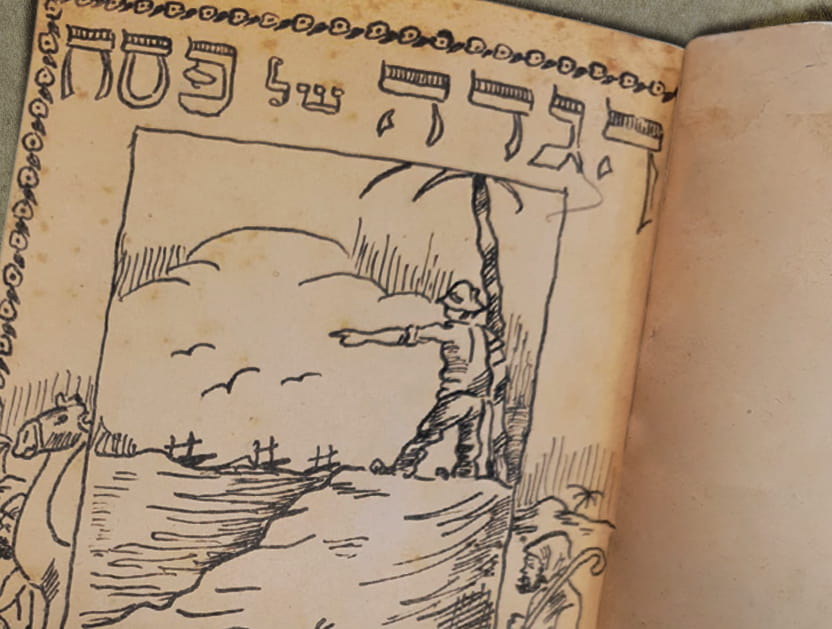The Holocaust of Carpatho-Russian Jewry
להגדלת הטקסט להקטנת הטקסטChaim Schalom Farkasch was born in Munkacz in 1925. His family was close to the Hassidic Rabbi of Munkacz. He describes the traditional activities of the Rabbi on Shabbat. On the Shabbat even many non-Jewish businesses were closed. He then talks about other Hassidic movements in the area, about the wedding of the Rabbi's son in 1933, and him becoming the Rebbe after his father's death in 1937. Chaim describes in detail the Jewish institutions in Munkacz: the court, the slaughter-house, the Mikvaot, the synagogues, yeshivot, etc. When Hitler divided Czechoslovakia, the area around Munkacz was allotted to Hungary who imposed antisemitic laws. Jews were enlisted with the "Labour Corps" and employed in detecting mines at the front. In 1941 those Jews that had not been enlisted with the Labour Corps, including Chaim's family, were taken to a transit camp, from where they were released after Chaim's sister managed to obtain papers showing the family's Hungarian citizenship. ; A little later all those Jews who had received orders to leave the country were taken to Ukraine, where about 60,000 were slaughtered. Those who returned home were allowed by Miklos Horty to remain, but Hungarian soldiers made their life impossible. Chaim describes the various stages of persecution, deportation of Jews to Kishtarazche (?) camp, the demand of 5 million dollars ransom, the establishment of a Judenrat, the personal experiences of Rabbi Rabinowitz of Munkacz who was smuggled out of the camp and went to Budapest to warn Jews of their future before travelling to Palestine in 1943. When the SS entered Munkacz, they sent all members of the Judenrat and other prominent Jews to Auschwitz. They established 2 ghettoes in Munkacz for about 100,000 Jews of the surrounding area. Later the ghetto was liquidated and they were deported to Auschwitz. ; Description of journey, arrival at Auschwitz, selection in isolation camp according to profession. Chaim declared he was a farmer. Description of his work and how they observed the Holy Days. After Chanukka he was taken to Gleiwitz and from there, after 12 days without food, to a factory and after another 3 days to another camp, where Chaim was ill with dysentery. In April 1945 they were transported by train again. When their train was bombed, they were forced to walk. On 23.4.45 they were told to run into the forests as they were being shot at. They were rescued by American soldiers coming from Duesseldorf. Chaim returned to Munkacz where they met a representative of Aliyah B. Chaim passed through Bucharest, Budapest, Austria and Italy on his way to Palestine. His 2 sisters survived. The interview ends with a discussion on how the holocaust affects the religious feelings of survivors.
| כותר |
The Holocaust of Carpatho-Russian Jewry. |
|---|---|
| כותרים נוספים |
שואת יהודי קרפטורוס |
| יוצרים נוספים |
Rosen, Ilana OHD (interviewer) רוזן, אילנה OHD (מראיין) פרקש, חיים OHD (מרואיין) המדור לתיעוד בעל פה של מכון המחקר ליהדות זמננו ע"ש אברהם הרמן באוניברסיטה העברית בירושלים (בעלים נוכחיים) |
| שנה |
2000 |
| הערות |
Digitization of this testimony has been made possible with the help of the Conference on Jewish Material Claims Against Germany, Inc. המדור לתיעוד בעל פה של מכון המחקר ליהדות זמננו ע"ש אברהם הרמן באוניברסיטה העברית בירושלים (245)6 |
| היקף החומר |
12 p. |
| שפה |
עברית |
| קרדיטים |
המדור לתיעוד בעל פה של מכון המחקר ליהדות זמננו ע"ש אברהם הרמן באוניברסיטה העברית בירושלים |
| מספר מערכת |
990044237240205171 |
בכל שימוש יש לציין את מקור הפריט בנוסח הבא:
המדור לתיעוד בעל פה של מכון המחקר ליהדות זמננו ע"ש אברהם הרמן באוניברסיטה העברית בירושלים
תנאי השימוש:
למחקר, לימוד והוראה
מותר להעתיק את הפריט ולהשתמש בו למטרות של לימוד עצמי, הוראה ומחקר בלבד.
מותר להעתיק את הפריט ולהשתמש בו גם למטרות הוראה ומחקר מסחריות.
חובה להעניק קרדיט ליוצר/ים בכל שימוש בפריט.
אסור לפגוע בכבודו או בשמו של היוצר באמצעות סילוף או שינוי של היצירה.
אין צורך לפנות לספרייה הלאומית לקבלת רשות שימוש למטרות לימוד עצמי הוראה ומחקר.
שימוש שאינו ללימוד עצמי, הוראה ומחקר, מותנה בקבלת הרשאה מבעל זכויות היוצרים בפריט ו/או מבעל האוסף. לא נדרש אישור נוסף מהספרייה הלאומית.
ניתן לפנות לספרייה הלאומית לקבלת פרטי הקשר של בעל זכויות היוצרים/בעל האוסף: טופס בקשה לבירור זכויות יוצרים
מידע נוסף:
הפריט כפוף לזכויות יוצרים ו/או לתנאי הסכם.
תנאי השימוש נקבעו בהסכם עליו חתמה הספרייה הלאומית.
אם לדעתך נפלה טעות בנתונים המוצגים לעיל או שקיים חשש להפרת זכות יוצרים בפריט, אנא פנה/י אלינו באמצעות טופס בקשה לבירור זכויות יוצרים
תצוגת MARC
יודעים עוד על הפריט? זיהיתם טעות?

 כניסה עם גוגל
כניסה עם גוגל
 כניסה עם פייסבוק
כניסה עם פייסבוק



